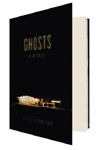The Wyoming of this collection, where “the withered [are] much in evidence,” is cold, potent, and often abused. The least-populous state among the lower forty-eight, this is a place where the “grouse are disappearing” and “gas rigs [are] sprouting like dandelions.” The inhabitants are smart, practical folk who scrape against the occasional tweaker or broken cowboy. Everyone shares in the struggle, even those riding high off the natural gas and oil boom. But Wyoming isn’t only a natural resources faucet: characters camp, ranch, and mountain climb; they traverse highways and rail lines, looking yearningly through windows at the “yawning of the country’s dry, broken hills.” “Wild, Wonderful Wyoming,” says an oil-pipe welder in the Red Dawg Bar, “the last place in America to get ahead.”
Eerie shadows drift through these pages and lives. In the solemn opener, “Border,” a fourteen-year-old runaway, haunted by the evil he’s exacted on his father, steals a collie puppy to comfort himself. “There’s plenty of haunting around here,” says Melanie, the Laramie Daily Boomerang reporter in “How Bitter the Weather.” She’s obsessed with the regular who’s missing from her local coffee shop, a man as ghostly as the apparitions of a man outfitted for the trenches of World War I or wearing a blue robe and pajamas: “soldiers playing cards in the parlor, men loitering in the front hall.” Apparitional haunting seems to occur for a purpose, especially the visitation of Grace Bedard’s ghost. The namesake of the “Bedard Collection of the Archives” in the library, she educates a doctoral student poking around her collection’s dusty shelves. “We left behind a miserable mess,” she says about the obliteration of Shoshone culture.
Two of the eight stories occur in the 1900s. “Brief Lives of the Trainmen” gives voice to crew workers—the engineer, cook, callboy, and a pounder—“building a rail line.” The work is agonizing and slow, and as “another mile of singing rail” gets “laid down like a babe,” the crew contemplates life on the “naked plains of the Wyoming Territory.” Reverend Porterfield, of “The Sin Eaters,” arrives in 1889, via rail. A missionary who wants to convert the Shoshone, his passage through outlaw cow-rustling territory is biblical. He encounters a landowner who speaks of Darwin and a roadhouse operator named Ella who sells pie, “and more,” to the men she serves. In both stories, the dialect is as hard and unpolished as the steel rail line. “Be...
You have reached your article limit
Sign up for a digital subscription and continue reading all new issues, plus our entire archives, for just $1.50/month.
Already a subscriber? Sign in





